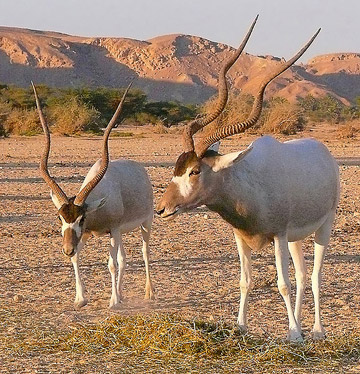Yesterday, the Niger government formally created the Termit and Tin Toumma National Nature and Cultural Reserve in the Sahara Desert, reports the Sahara Conservation Fund. The reserve, now one of the largest in Africa, expands existing protected areas to 100,000 square kilometers (38,610 square miles), an area bigger than Hungary and nearly twice the size of Costa Rica.
The Sahara Conservation Fund calls the new park “a vast new protected area whose management will benefit both wildlife and local nomadic people through improved habitat use and the development amongst others of appropriate ecotourism.”
 Captive addax in Israel. This antelope is Critically Endangered. Photo by: Math Knight. |
The reserve contains three animals listed as Critically Endangered on the IUCN Red List: the addax (Addax nasomaculatus), considered the world’s most imperiled antelope species; the dama gazelle (Nanger dama); and the Saharan cheetah (Acinonyx jubatus hecki), a subspecies of cheetah with only about 250 individuals left. The Termit and Tin Toumma Reserve holds what is believed to be the largest population of addax left.
Home to a total of 30 mammals and around 160 birds, the park also sports populations of Barbary sheep (Ammotragus lervia), listed as Vulnerable; sand cat (Felis margarita), Near Threatened; Dorcas gazelle (Gazella dorcas), Vulnerable; lappet-faced vulture (Torgos tracheliotos), Vulnerable; the Nubian bustard (Neotis nuba), Near Threatened; the African spurred tortoise (Geochelone sulcata), Vulnerable; and rarely studied pale fox (Vulpes pallida), Data Deficient.
The region was once one of the last strongholds of the scimitar oryx (Oryx dammah) before it went extinct in the wild, although there are still tantalizing, although unconfirmed, reports of scimitar oryx in Termit and Tin Toumma.
According to the Sahara Conservation Fund conservation fund the biggest threats to the region’s wildlife are poaching and possibly oil development.
Related articles
Photos: Rarest cheetah photographed for the first time

(02/23/2009) With only 250 individuals left the Saharan Cheetah is on the brink of extinction. Little-studied, this imperiled subspecies has been photographed for the fist time by scientists from by the Zoological Society of London (ZSL) and Office du Parc National de l’Ahaggar (OPNA) using camera traps. “The Saharan cheetah is critically endangered, yet virtually nothing is known about the population, so this new evidence, and the ongoing research work, is hugely significant,” said Dr Sarah Durant, a Senior Research Fellow with ZSL.
All about giraffes: an interview with a giraffe expert

(03/09/2009) Dr. Julian Fennessy probably knows the giraffe better than anyone. Trekking across savannah, forest, and the deserts of Africa, Fennessy is collecting genetic samples of distinct giraffe populations and overturning common wisdom regarding their taxonomies. It had long been accepted knowledge that the giraffe was made up of one species and several subspecies, however with Fennessy’s work it now appears that several of the subspecies may in fact be distinct species. Such discoveries could have large conservation impacts, since conservation funds and efforts are largely devoted to species. The giraffe has suffered significant declines in the past decade with the total population dropping some 30 percent across Africa.
Great Green Wall gets go ahead
(02/28/2011) Spanning the entire continent of Africa, including 11 nations, the Great Green Wall (GGW) is an ambitious plan to halt desertification at the Sahara’s southern fringe by employing the low-tech solution of tree planting. While the Great Green Wall was first proposed in the 1980s, the grand eco-scheme is closer to becoming a reality after being approved at an international summit last week in Germany as reported by the Guardian.














